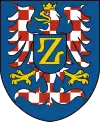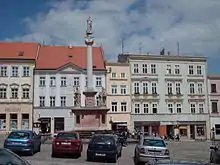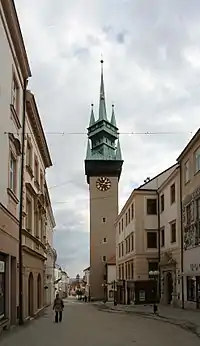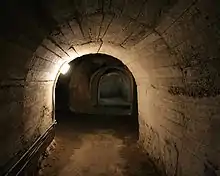Znojmo
Znojmo (Czech pronunciation: [ˈznoimo]; German: Znaim) is a major town in the South Moravian Region of the Czech Republic, the administrative capital of the Znojmo District. It has about 34,000 inhabitants. It is the historical and cultural centre of southwestern Moravia and the second most populated town in the South Moravian Region. The historic centre of Znojmo is well preserved and historically significant and is protected by law as urban monument reservation.
Znojmo | |
|---|---|
Town | |
 St Nicholas' Church | |
 Flag  Coat of arms | |
 Znojmo Location in the Czech Republic | |
| Coordinates: 48°51′20″N 16°2′56″E | |
| Country | |
| Region | South Moravia |
| District | Znojmo |
| Founded | between 1222–1225 |
| Government | |
| • Mayor | Jakub Malačka |
| Area | |
| • Total | 65.93 km2 (25.46 sq mi) |
| Elevation | 290 m (950 ft) |
| Population (2020-01-01[1]) | |
| • Total | 33,765 |
| • Density | 510/km2 (1,300/sq mi) |
| Time zone | UTC+1 (CET) |
| • Summer (DST) | UTC+2 (CEST) |
| Postal code | 669 02 |
| Website | www |
Geography
The town is situated on a rock outcropping on the steep left bank of the Thaya River, about 55 km (34 mi) southwest of the regional capital Brno. Located near the border with Austria, it is connected to Vienna by railway and road (about 80 minutes).
History

A fortress at the site possibly already existed during the time of the Great Moravian Empire in the 9th century. From about 1055, Znojmo Castle served as the residence of a Přemyslid principality within the Bohemian March of Moravia and a strategic important outpost near the border with the Bavarian March of Austria in the south. Few years later (1101), Luitpold of Znojmo, Duke of Moravia, established the Ducal Rotunda of the Virgin Mary and St Catherine in this castle, later depicted by unique scene of genealogy Bohemian and Moravian Dukes of the Přemyslid dynasty and the castle was conquered and devastated by Duke Vladislaus II of Bohemia in 1145.
In 1190, Duke Conrad II of Bohemia founded the Premonstratensian Louka Abbey at Znojmo, which became the settlement area of German-speaking immigrants in the course of the medieval Ostsiedlung movement. The royal city of Znojmo was founded shortly before 1226 by King Ottokar I of Bohemia on the plains in front of the reconstructed castle. The town privileges were confirmed by King Rudolf I of Germany in 1278. On 9 December 1437 the Luxembourg emperor Sigismund died at Znojmo and lay in state for three days at the St. Nicholas Church, before his mortal remains were transferred to Oradea in Hungary.
From the 19th Century, Znojmo is best known as the site for the Armistice of Znaim concluded there on 12 July 1809 during the Battle of Znaim, after the decisive 7 days earlier Battle of Wagram, between Emperor Napoleon and the archduke Charles.
From the 20th Century, it is also the (alleged) birthplace of Leopold Loyka, the driver of Austrian Archduke Franz Ferdinand's car when Ferdinand was assassinated in Sarajevo during 1914, an event which triggered the World War I. After the war, it was part of Czechoslovakia, except during the Nazi German occupation between 1938 and 1945 when it was part of Reichsgau Niederdonau. The German Citizens were expelled in 1945 according to the Beneš decrees.
The birthplace of the sculptor Hugo Lederer and writer Charles Sealsfield, it also has a special co-operation relation with Harderwijk, Netherlands.
Sights
The Gothic Church of St. Nicholas and the Late Gothic Town Hall tower are the most recognizable landmarks. St Nicolas Church was built in 1348 by Emperor Charles IV, and the town hall, with its 75 m (250 ft) tower, dates from around 1446.[2]
Overlooking the Thaya River valley, on the edge of the medieval city, there is Znojmo Castle, dating back to 11th century, founded by Přemyslid dukes.[3] The only remains of the castle used by the Přemysl dukes is the Romanesque Rotunda of Saint Catherine, the interior of which is covered with 11th-century frescoes depicting biblical scenes and illustrating the life of Přemysl.[4]
Under the town and castle is a vast labyrinth of connected passageways and cellars, Znojmo Catacombs, developed in the 14th and 15th century for defensive purposes and containing wells, drainage, fireplaces, trap doors and escapeways that led beyond the fortifications of the town.[5][6] The catacombs are the largest system of underground corridors and cellars in the Czech Republic - they are almost 27 km long and up to 4 levels deep.[7]
Agriculture, viticulture and nature
Znojmo is famous for local production of cucumbers, pickled in the original sweet-sour and spicy pickle, whose cultivation in the Znojmo region was introduced in 1571 by Louka monastery Abbot George II, coming from North Bohemian village Čepirohy. The special taste is also the result of local type of cucumbers, cultivation method, soil, climatic conditions, processing and also the packaging in which they are kept. These are also an ingredient of local specialties such as Znojmo roast or Znojmo goulash. Nowadays, the cucumber festivals are held in the town every year.
Thanks to favorable climatic conditions, the town is successful also in winery and fruit growing. It is the center of viticulture of the Znojmo wine-growing sub-region and a destination for nature lovers, mainly thanks to the newly established National Park "Podyjí".

_1.jpg.webp)
Sport
• 1. SC Znojmo FK is a local football club which plays in the Moravian–Silesian Football League (3rd tier of the Czech football league system).
• Orli Znojmo is a local ice hockey club playing the Austrian Hockey League (also known as the Erste Bank Eishockey Liga, or EBEL)
Culture
Znojmo is well known for its wine festival that takes place every September. The main attraction of the festival is a historical parade celebrating coming of king John of Bohemia.
Notable people
- Václav Prokop Diviš (1698–1765), priest, theologian and natural scientist, pioneer in the field of electricity and the constructor of the first electric musical instrument Denis d'or
- Clement Mary Hofbauer, C.Ss.R. (1751–1820), Redemptorist priest and patron saint of Vienna, who served as an apprentice baker in the town in his youth
- Anna Spitzmüller (1903–2001), art historian and curator
- Petr Rosol (born 1964), ice hockey player
- Jitka Schneiderová (born 1973), actress
- Květoslav Svoboda (born 1982), swimmer
- Michal Ordoš (born 1983), football player
- Jiří Orság (born 1989), weightlifter
Twin towns – sister cities
 Chrudim, Czech Republic
Chrudim, Czech Republic Nové Zámky, Slovakia
Nové Zámky, Slovakia Pontassieve, Italy
Pontassieve, Italy Povo (Trento), Italy
Povo (Trento), Italy Retz, Austria
Retz, Austria Ružinov (Bratislava), Slovakia
Ružinov (Bratislava), Slovakia Strzegom, Poland
Strzegom, Poland Torgau, Germany
Torgau, Germany Villazzano (Trento), Italy
Villazzano (Trento), Italy
References
- "Population of Municipalities – 1 January 2020". Czech Statistical Office. 2020-04-30.
- Beseda, Znojemská. "Znojemská Beseda". www.znojemskabeseda.cz. Retrieved 2017-01-24.
- Beseda, Znojemská. "Znojemská Beseda". www.znojemskabeseda.cz. Retrieved 2017-01-24.
- Beseda, Znojemská. "Znojemská Beseda". www.znojemskabeseda.cz. Retrieved 2017-01-24.
- http://www.istudio.cz, iStudio s.r.o. -. "Underground in Znojmo - Top Výletní cíle jižní Morava". www.vyletnicile.cz. Retrieved 2017-01-24.
- Beseda, Znojemská. "Znojemská Beseda". www.znojemskabeseda.cz. Retrieved 2017-01-24.
- "Tip for a Trip: Znojmo | Foreigners.cz Blog". blog.foreigners.cz. 2020-07-28. Retrieved 2020-10-01.
- "Partnerská města" (in Czech). Znojmo. Retrieved 2020-06-27.

